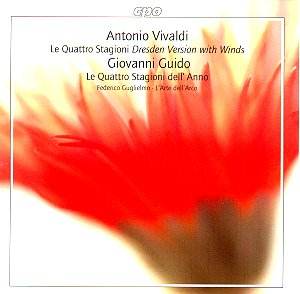Comparison recordings:
Tomasow, Janigro, I Solisti di Zagreb
[ADD] Vanguard Bach Guild OVC 2536
There is a story about
Arnold Schoenberg that bears retelling
now. He was in the midst of teaching
a class at UCLA when a colleague burst
in excitedly proclaiming "Arnold!
I am just hearing Verklärte
Nacht mit HORNS!" Amid much
startled posturing the two rushed out
to destinations unknown, leaving the
class unacknowledged. But all the various
arrangements of Schoenberg’s work (I’ve
never heard it with horns, but the string
orchestra version with timpani is quite
a good one) don’t begin to compare with
the numerous outrages wreaked upon this
helpless Vivaldi composition.
And here we hear it
with horns. Federico Guglielmo has reconstructed
a hypothetical arrangement in the style
of Pisendel for the Dresden Orchestra,
with wind parts — an inauthentic version
is of a highly authentic nature. You
know you’re not in Kansas any more when
the opening tutti clearly has trumpets
in the orchestra and the first violin
solo turns into a duetto with sopranino
recorder. The famous dog barks are played
on wooden cornets, and don’t sound quite
so canine as the col legno viola
notes in the Harnoncourt version. The
last movement of La Primavera
begins with what sound like wooden trombone
fanfares. Naturally the horn calls at
the beginning of L’Autonno are
played by, among other instruments,
horns. The beautiful melody in L’Inverno
which Jan Tomasow plays with such a
gorgeous, generous, singing line is
here fussed over and fiddled with, and
loses all cantilena. By the time the
whole orchestra gets into the act, the
final storm in L’Inverno is one
storm you don’t want to be out in. Of
course the violinist improvises generously
but not outrageously during his solos.
Recorder and violin trade solo duty,
the recorder particularly appearing
where bird-songs are being imitated.
The possibilities for
this sort of thing are enormous — imagine
Bach’s Chromatic Fantasy and Fugue
as arranged by Mozart and performed
by Beethoven, or, closer to home, "I
Wanna Hold Your Hand" as arranged
by Liszt and performed by Godowsky.
Well now that we know
what we’re up against, is it any good?
Yes, it is; the music is quite recognisable
and the expanded sonority does little
violence to the style and is certainly
more listenable than some versions.
Compared to the Tomasow version, which
Igor Stravinsky and I consider the best
of the conventional performances (the
one by Leopold Stokowski isn’t bad either),
the Guglielmo version is not so sweet
of sound, interestingly varied, and
affectingly and dramatically phrased.
But the question is: is it necessary?
Does this arrangement give us something
we didn’t have before and is that something
desirable? It is true that some of the
places in Vivaldi’s concerto where the
violin imitates bird-calls are now played
on a recorder and sound more like a
bird, and some other places where the
violin imitates horn-calls are now played
on horns. The piece is now less of a
virtuoso violin work because the violin
has less work to do, becoming more a
member of the orchestra with occasional
concertato passages to play.
In other works the Four Seasons
become more of an orchestral work and
less of a set of violin concertos. If
that is what you want, then this disk
is for you.
Next on the disk following
Guglielmo’s version of the Vivaldi we
have a free fantasia based on the Vivaldi
work by Giovanni Guido, who was 18 years
older than Vivaldi. This is a more straightforward
improvisation and Vivaldi isn’t mentioned
in the title; it answers the question:
Why fool around with somebody else’s
music when you can just write your own?
Tippett’s Fantasia Concertante on
a Theme by Corelli and Werner Egk’s
Suite after Rameau are other
more recent examples of this genre,
but of course Guido was actually older
than Vivaldi and must have written this
work only very shortly after Vivaldi’s
original. Guido’s take-off is less than
half as long as his model, and since
he does not copy exactly any tunes,
only textural fragments, it is a genuine
composition "in the style of"
the Vivaldi. Is it as good a piece of
music? No, but certainly showing much
skill and sensitivity and interesting
to hear a few times.
Sound in the SACD version
is clear and the sense of ambient space
is nothing short of breathtaking, although
the orchestra remains in front, with
the instruments clearly differentiated,
and only ambient information comes from
the rear. However the acoustic is live
and very realistic.
Paul Shoemaker


